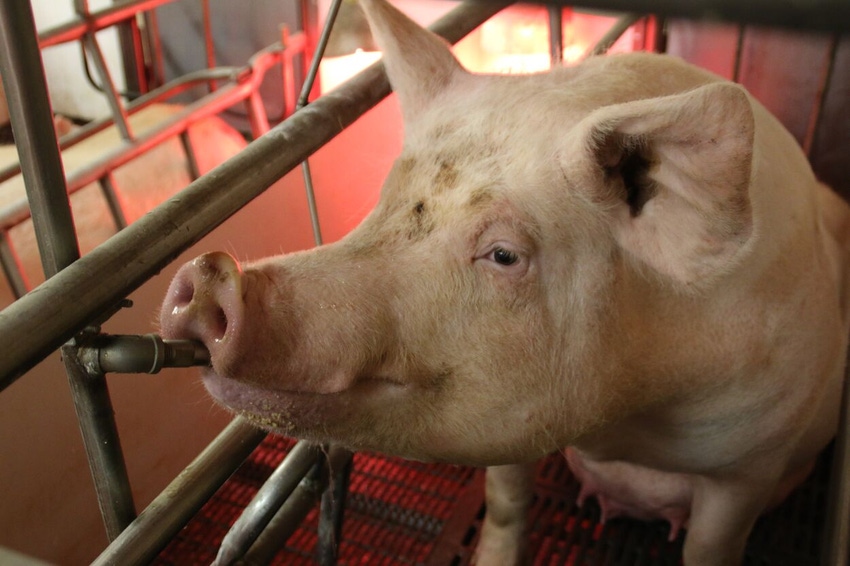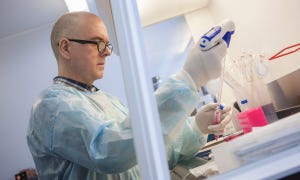Detecting PRRSV RNA in acutely infected sows
Potential for tonsil oral scraping as a novel, practical and rapid tool.
January 2, 2024

By Peng Li, Ana Paula Poeta Silva, Daniel Moraes, Onyekachukwu Henry Osemeke, Edison Magalhaes, Gustavo Silva and Daniel Linhares, Iowa State University; and Paul Yeske, Swine Vet Center
There are several well-established population-based sample types, such as processing fluids, family oral fluids and tongue tip fluids to monitor porcine reproductive and respiratory syndrome virus activity in suckling pigs (Almeida et al., 2020; Baliellas et al., 2021; Lopez et al., 2022; Lopez et al., 2020; Machado et al., 2022; Vilalta et al., 2018). These aggregated samples are from the suckling piglet sub-population.
While the population-based sample types enable sampling more animals providing increased herd sensitivity, they are not useful to provide individual information for estimating prevalence. Moreover, samples originating from suckling piglets cannot directly determine individual sow status for PRRSV. Therefore, an effective and practical tool to directly sample sows is needed because sows are a major source of PRRSV infection to piglets (Pileri & Mateu, 2016).
Commonly used sampling methods for the sows to detect pathogens include serum and tonsil scraping (Nielsen et al., 2005; Tousignant et al., 2017; Wills et al., 2003). However, serum and tonsil scraping are time-consuming and labor-intensive for large screening especially in low prevalence scenarios where relatively large sample sizes are required to detect at least one positive animal. Moreover, both methods require the restraining of sows, which causes stress and requires skilled labor.
A novel sow tonsil-oral scraping sampling method was created by our team by modifying a sow collector developed by New Hope Swine Research Institute, which is widely used for the test-and-removal of ASFV infected sows in China (Li, 2022; Figure 1). TOSc collects biological samples of fluids from a sampled sow's tonsillar area in less than one minute without snaring.

ISU. Figure 1. TOS collector prototype adapted by our group.
This study aimed to compare TOSc to serum and tonsil scraping in terms of PRRSV RNA qPCR detection rate and Ct values in thirty matched sows, thirty days after a PRRSV outbreak.
Methods
A cross-sectional study was performed in a 2,400 breed-to-wean herd seeking to eliminate PRRSV following a recent outbreak. Thirty sows in the farrowing crates were conveniently selected and sampled for PRRSV qPCR testing. Serum, tonsil scraping and TOSc were collected from each of the 30 sows.
TOSc was collected without restraining the sows (Figure 2). The head of the AI rod was placed beside the mouth of the sow to attract her attention. The rod was then inserted into the sow’s mouth, with the help of a headlamp, directed toward the tonsil area with an upwards angle and scrubbed back and forth for ten seconds. The qualified sample was defined as viscous and mucous-like.
The head part of the rod containing the sample was cut by a sterilized clip and then transferred to a 50 ml conical tube with two ml of PBS. Additionally, tonsil scraping and serum were collected when the sows were restrained. All samples were tested for PRRSV RNA detection by RT-rtPCR, and the probability of RNA detection and Ct values were compared between groups.

ISU. Figure 2. TOSc sampling in the acutely infected farm. TOSc collector before collection (left), sample collection (middle), and TOSc samples after collection(right).
Results
As shown in Table 1, TOSc had a PRRSV RNA detection rate of 99.6%, with a 95% credibility interval between 95.1%-100%, which was significantly higher compared with serum 16.7% (5.7%-30.7%), and tonsil scraping 73.5% (57.3%-87.6%). There was no significant difference in the detection rate between TOSc and tonsil scraping, while there was a significant difference between serum and tonsil scraping, as well as between serum and tonsil scraping.
TOSc showed numerically lower average Ct values (29.7) than tonsil scraping (30.7) and serum (35.2). There was no statistically significant difference between Ct values from TOSc and tonsil scraping samples, while there was a significant difference between Cts from tonsil scraping and serum, and of Cts from TOSc and serum.
ISU. Table 1. PRRSV detection rate and average Ct values of three different sample types in 30 sows.
Conclusion and discussion
TOSc recovered a mixture of biological samples from oral and tonsillar areas within seconds without restraining the sows. Statistically, there was no significant difference between TOSc and tonsil scraping, while there was a significant pairwise difference between serum and tonsil scraping/TOSc. Our results suggest great potential of the TOSc as a novel, practical, and rapid tool for PRRSV RNA detection in sows to assess sow herd status.
Further field studies are needed to further validate TOSc sampling compared to other commonly used sow sampling methods.
References
Almeida, M. N., Rotto, H., Schneider, P., Robb, C., Zimmerman, J. J., Holtkamp, D. J., Rademacher, C. J., & Linhares, D. C. L. (2020). Collecting oral fluid samples from due-to-wean litters. Prev Vet Med, 174, 104810. https://doi.org/10.1016/j.prevetmed.2019.104810
Baliellas, J., Novell, E., Enric-Tarancon, V., Vilalta, C., & Fraile, L. (2021). Porcine Reproductive and Respiratory Syndrome Surveillance in breeding Herds and Nurseries Using Tongue Tips from Dead Animals. Vet Sci, 8(11). https://doi.org/10.3390/vetsci8110259
Brent Pepin, F. L., Roger Main, Alejandro Ramirez, Jeffrey Zimmerman;. (2015). collection of oral fluid from individually housed sows. Journal of Swine Health and Production, 23.
Li, Z. J. Y. X. L. W. W. P. (2022). Eliminating African Swine Fever Viruses in Four Large Sow Herds by New Generation Test-Removal Technology in China from 2018 to 2019. International Pig Veterinary Conference.
Linhares, D. C., Cano, J. P., Torremorell, M., & Morrison, R. B. (2014). Comparison of time to PRRSv-stability and production losses between two exposure programs to control PRRSv in sow herds. Prev Vet Med, 116(1-2), 111-119. https://doi.org/10.1016/j.prevetmed.2014.05.010
Lopez, W., Zimmerman, J., Gauger, P., Harmon, K., Magtoto, R., Bradner, L., Holtkamp, D., Zhang, M., Zhang, J., Ramirez, A., Linhares, D., & Gimenez-Lirola, L. (2022). Considerations in the use of processing fluids for the detection of PRRSV RNA and antibody. J Vet Diagn Invest, 34(5), 859-863. https://doi.org/10.1177/10406387221114855
Lopez, W. A., Zimmerman, J. J., Gauger, P. C., Harmon, K. M., Bradner, L., Zhang, M., Gimenez-Lirola, L., Ramirez, A., Cano, J. P., & Linhares, D. C. L. (2020). Practical aspects of PRRSV RNA detection in processing fluids collected in commercial swine farms. Prev Vet Med, 180, 105021. https://doi.org/10.1016/j.prevetmed.2020.105021
Machado, I. F., Magalhaes, E. S., Poeta Silva, A. P. S., Moraes, D. C. A., Cezar, G., Mil-Homens, M. P., Osemeke, O. H., Paiva, R., Moura, C. A. A., Gauger, P., Trevisan, G., Silva, G. S., & Linhares, D. C. L. (2022). Porcine reproductive and respiratory syndrome virus RNA detection in tongue tips from dead animals. Front Vet Sci, 9, 993442. https://doi.org/10.3389/fvets.2022.993442
Nielsen, E. O., Lauritsen, K. T., Friis, N. F., Enoe, C., Hagedorn-Olsen, T., & Jungersen, G. (2005). Use of a novel serum ELISA method and the tonsil-carrier state for evaluation of Mycoplasma hyosynoviae distributions in pig herds with or without clinical arthritis. Vet Microbiol, 111(1-2), 41-50. https://doi.org/10.1016/j.vetmic.2005.08.009
Tousignant, S. J. P., Bruner, L., Schwartz, J., Vannucci, F., Rossow, S., & Marthaler, D. G. (2017). Longitudinal study of Senecavirus a shedding in sows and piglets on a single United States farm during an outbreak of vesicular disease. BMC Vet Res, 13(1), 277. https://doi.org/10.1186/s12917-017-1172-7
Vilalta, C., Sanhueza, J., Alvarez, J., Murray, D., Torremorell, M., Corzo, C., & Morrison, R. (2018). Use of processing fluids and serum samples to characterize porcine reproductive and respiratory syndrome virus dynamics in 3 day-old pigs. Vet Microbiol, 225, 149-156. https://doi.org/10.1016/j.vetmic.2018.09.006
Wills, R. W., Doster, A. R., Galeota, J. A., Sur, J. H., & Osorio, F. A. (2003). Duration of infection and proportion of pigs persistently infected with porcine reproductive and respiratory syndrome virus. J Clin Microbiol, 41(1), 58-62. https://doi.org/10.1128/JCM.41.1.58-62.2003
You May Also Like



